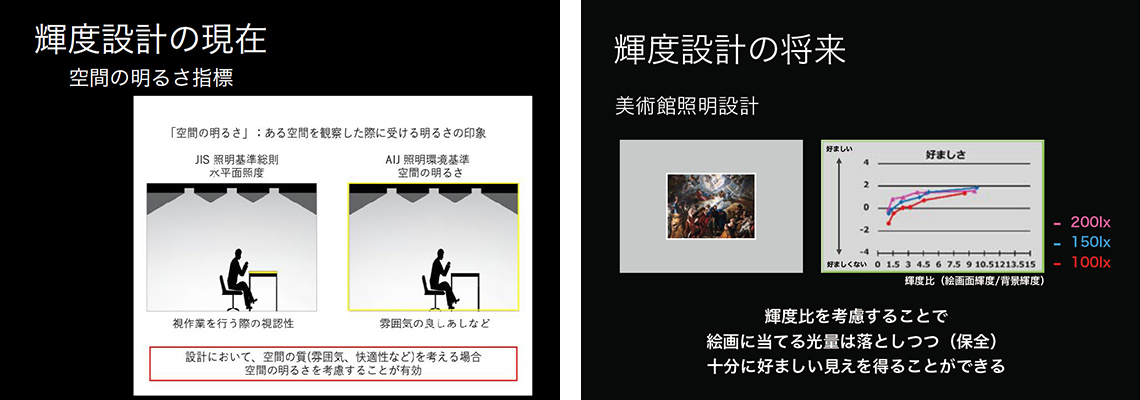As lighting simulation software such as DIAlux has become easier to use, the next challenge is how to connect the quantified/visualized simulation results with “people’s senses.” This requires an index for evaluating a “sense of brightness”. Hints for this can be found in the much-studied “shift from illuminance-based design to luminance-based design.” Applications in lighting designs are discussed in this session by Professor Nozomu Yoshizawa from Tokyo .

Yoshizawa started the session with an overview of the past, present, and future of luminance-based designs. Since the 1950s, it has been said that luminance is essential for lighting designers regardless of age. Luminance used to be difficult to consider in the actual design but has become easier to handle in recent years thanks to lighting simulations. Major contributing factors include reduced simulation time due to the higher performance of computers, the ability to calculate luminance distribution when designing, and the ability to measure luminance distribution in an entire space, using digitally processed photographic photometry. In that sense, lighting simulations can be highly effective, essential tools for future lighting designers.

Meanwhile, there are problems with luminance, including the lack of a definitive index. In order to address this issue, various proposals have been made by manufacturers and research organizations. In 2016, the Architectural Institute of Japan published the Standards for Lighting Environment s, which employed luminance as a standard index focusing on the brightness of spaces. Therefore, movements related to practical uses of luminance-based design are becoming more active in various areas.

Next, Iwai introduced the circumstances when he feels luminance-based designs are necessary, based on his experiences and project plans.
Using the example of the National Art Center, Tokyo , he explained how he planned indirect lighting?light leaking through a pergola ?under the concept of a museum in a forest. He said it was important to check the luminance balance between the ceiling and walls, and the upper and bottom parts of the wall. However, luminance could not be sufficiently verified by simulations at that time, so he used models and a mock-up for persuading the public.
Now simulations by DIALux can be verified with luminance evaluation software, enabling the recreation of various situations for verification.

At the end of this session, Iwai requested that researchers establish a method for smoothly eliciting a luminance rating based on simulation, and for people to experience the result using tools such as head-mounted displays. Yoshizawa responded that although it was impossible with illuminance, luminance should be explained by how it is visually seen. Therefore, he concluded that it should be possible to develop an informative evaluation axis and a mode of expression in the future.
【Date & Time】15:30‒16:30, March 6, 2019
【Venue】Room 102, 1F, Conference Tower, Tokyo Big Sight
【Speaker】Nozomu Yoshizawa, Professor, Tokyo University of Science Tatsuya Iwai, Representative, IWAI LUMIMEDIA DESIGN
【Moderator】Yasuyuki Tomita, Principal, TOMITA LIGHTING DESIGN OFFICE INC.
【Organizers】IALD Japan, JLMA, Nikkei Inc.
Profile
Nozomu Yoshizawa
Education: 1993-1998 Dept. of Architecture, Grad. School of Eng., The University of Tokyo, Awarded the degree of PhD in Engineering (The University of Tokyo),
Professional Experience: 2010 - present Department of Architecture, Tokyo University of Science,
Speciality: Architectural Lighting, Daylighting, Museum Lighting, Lighting Design Tool
Tatsuya Iwai
Education: 1975-1980 The School of Architecture, College of Science and Technology, Nihon University Professional Experience: 1996 – present Iwai Lumimedia Design 1980-1996 Technical Lighting Yamagiwa Laboratory Inc.
Speciality: Lighting Design
Yasuyuki Tomita
After graduation, joined Motoko Ishii Lighting Design Inc.(1980-1995). founded TOMITA LIGHTING DESIGN OFFICE INC. in1997.







